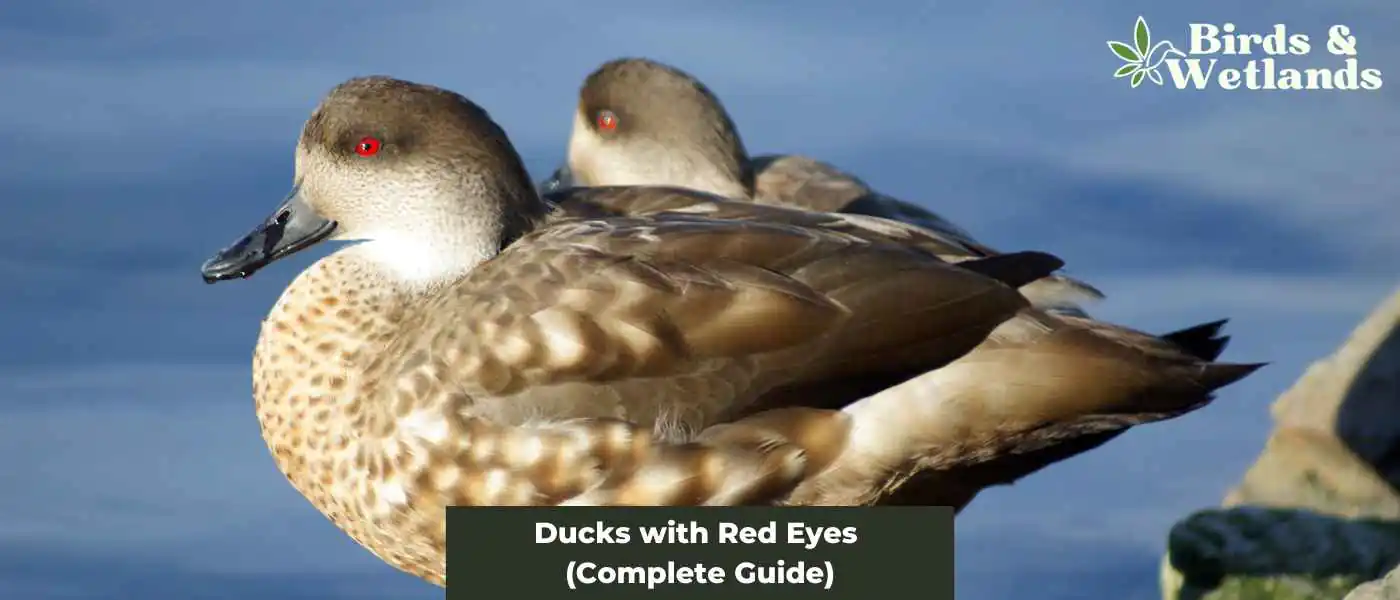You may have seen ducks with red eyes waddling along the banks of a pond or gracefully swimming in a lake, but have you ever stopped to admire their unique and enigmatic trait? These fascinating creatures have long captured the attention of nature enthusiasts and bird watchers, drawing in admirers with their striking appearance and charming personalities.
Despite their distinct beauty, ducks with red eyes are often misunderstood or even overlooked. So, in this post, we’ll delve deeper into the world of these magnificent creatures, exploring their fascinating features and celebrating their one-of-a-kind charm. Let’s get started!
Wood Duck
Wood Duck

- A stunning duck species commonly found in wooded swamps, marshes, and ponds
- Easily identifiable by their unique and colorful appearance
- Known for fascinating behaviors such as nesting in trees and impressive flying abilities
Wood ducks, also known as Carolina ducks, are small dabbling ducks found in wooded swamps, marshes, and ponds throughout the eastern North America and southern British Columbia.
Wood ducks are easily identifiable by their unique and colorful appearance, with a striking mix of iridescent green, blue, and chestnut feathers on their bodies.
The male wood duck has a distinct crested head, red eyes, and a white flare extending from the sides of its bill. It also has a white belly. The female is less colorful but equally beautiful, with a gray-brown head and a white teardrop-shaped eye-ring. The striking appearance of the male wood duck makes it one of the most sought-after species by birdwatchers and nature enthusiasts.
Wood ducks also have fascinating behaviors. These dabbling ducks are the only North American duck species that nests in tree holes, often man-made nest boxes. The mother wood duck uses her sharp claws to climb the tree and carefully guides her chicks to the water once they hatch.
Despite having relatively short wings than other species, wood ducks are also known for their impressive flying abilities, with the ability to reach speeds of up to 60 miles per hour. They fly long distances in winter and early spring.
Conservation efforts have helped to restore the populations of wood ducks, which were once threatened due to hunting and loss of habitat. Today, many states and organizations have developed programs to monitor and protect wood duck populations.
One example is the construction of nest boxes in suitable habitats, which has successfully increased the nesting success of these birds.
Cinnamon Teal
Cinnamon Teal
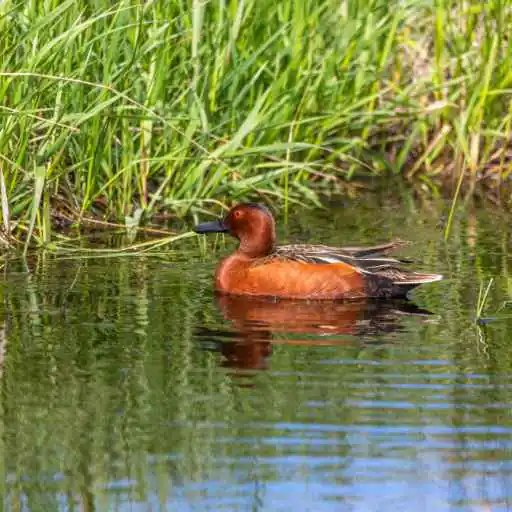
- Easily recognizable by their striking cinnamon-colored plumage
- Prefers freshwater habitats and
- Primarily herbivorous, with a specialized bill
Cinnamon teal is a species of dabbling duck found in North and South America, from southern Canada down to northern parts of South America. These ducks are named for their striking cinnamon-colored plumage, which is more prominent in adult males than females.
Cinnamon teals are medium-sized ducks, with males measuring around 14-15 inches in length and females being slightly smaller. They are easy to recognize due to their bright, reddish-brown heads and necks, contrasting with their gray bodies and bright blue patches on their wings. Females have reddish-brown eyes and have more muted colors, with a brownish-gray head and a blue-gray patch on their wings.
These ducks form large flocks and inhabit freshwater habitats, including marshes, ponds, and lakes, but they prefer shallow wetlands with plenty of vegetation in non-breeding season.
Cinnamon teals are primarily herbivorous, feeding on various aquatic plants and seeds and small invertebrates like snails and insects. Like other birds, they can filter out small food items from the water with specialized bills, which have comb-like structures on the edges that help them sift through their food.
During the breeding season, males perform courtship displays to attract mates, which involve swimming in circles with their necks extended and their tails raised. Females lay their eggs in a concealed nest near the water.
Although cinnamon teals are not considered to be threatened, their populations have declined in some areas due to habitat loss and degradation. Conservation efforts are focused on preserving and restoring wetland habitats and reducing hunting and other human impacts on their populations.
Muscovy Duck
Muscovy Duck
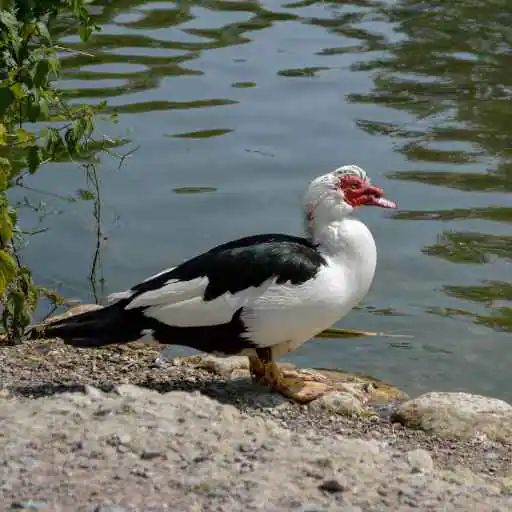
- Large waterfowl
- Generally solitary creatures
- Mates for life
Muscovy ducks (Cairina moschata) are fascinating birds found throughout much of the Americas. They are known for their unique appearance and behavior, making them a favorite among bird enthusiasts.
Muscovy ducks are a large breed of waterfowl, with males weighing in at an average of 10-15 pounds and females weighing 5-8 pounds.
They have a distinctive appearance, with bare, red skin around their eyes and on their faces, often described as “warty.” It has the same color as bare skin. Their feathers can range in color from black and white to iridescent greens and purples, and their wingspan can reach up to six feet.
Unlike other ducks, Muscovy ducks are not very social creatures and are often seen in pairs or small groups.
Their diet consists of various foods, including insects, snails, and plants. They are also known to eat small fish and even small mammals like rodents.
Muscovy ducks are monogamous, meaning they mate with one partner for life. They build their nests in tree cavities or other elevated areas, and the female will lay around 8-16 eggs per clutch. After hatching, the ducklings will remain with their parents for several months.
Muscovy ducks are considered to be a species of “least concern” by the International Union for Conservation of Nature (IUCN). They are not considered to be threatened or endangered. However, their populations have declined in some areas due to habitat loss and hunting.
All domestic Muscovy ducks originated from the same species, the true wild Muscovy duck which had a black body with white wing patches.
Red-Breasted Merganser
Red-Breasted Merganser

- Dives underwater in pursuit of prey
- Communicates vocally using a range of calls and sounds
- Builds a nest on the ground
The red-breasted merganser (Mergus serrator) is a striking and fascinating species of waterfowl that can be found in many parts of the world. These birds are often recognized by its their thin beaks, behavior, and vocalizations, making them favorites among bird enthusiasts and nature lovers.
Male red-breasted mergansers are medium-sized ducks with long, thin bills that are serrated on the edges. They are known for their stunning appearance, with a bold black-and-white coloration, white underparts, a rusty red breast and green sheen.
The females are slightly smaller than the males and have a more muted appearance. During breeding, males will develop a striking green iridescence on their heads. Females’ rising squeal sounds like “do-weep.”
Red-breasted mergansers are known for their unique foraging habits, as they dive underwater in search of fish and other prey. They can stay submerged for up to a minute, using their serrated bill to catch and hold onto their catch.
These ducks are also highly vocal, with a range of calls and sounds that they use to communicate with other members of their flock.
During the breeding season, male red-breasted mergansers will put on an impressive courtship display to attract a mate. This display includes head bobbing, bill dipping, and even jumping out of the shallow water. Females will select a mate based on the quality of their display.
After mating, the female will build a nest on the ground or in a tree cavity, where she will lay up to 12 eggs. The young will leave the nest and join their mother in the water shortly after hatching.
Red-Crested Pochard
Red-Crested Pochard
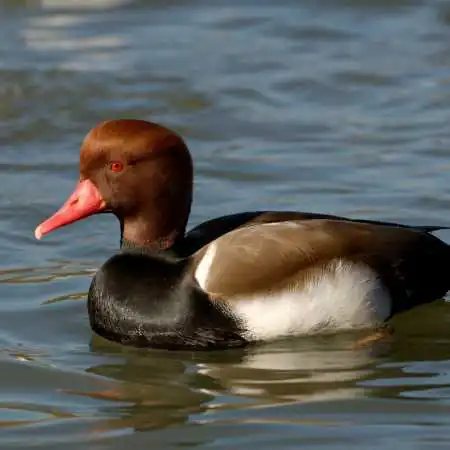
- Named after the reddish-brown crest on its head
- Prefers freshwater habitats such as lakes, ponds, and rivers
- Feeds on aquatic plants
The red-crested pochard (Netta rufina) is a colorful and striking bird native to Europe and Asia.
The adult male is easy to recognize because of its unique appearance. Its head is round and bright orange, and it has a red bill that stands out. The breast is black, while the flanks are white, and the back is brown. The tail is black and webbed feet are darkish orange.
Red-crested pochards are diving ducks found in freshwater wetlands, such as lakes, ponds, and rivers with dense aquatic vegetation. They are also known to frequent brackish coastal wetlands and rice paddies.
During breeding season, they prefer shallow, heavily vegetated water bodies with abundant food resources, while in winter they can be found in deeper, open water bodies.
Red-crested pochards are omnivores and their diet varies based on the season and habitat. During the breeding season, they primarily feed on aquatic plants such as pondweeds, sedges, and reeds, as well as small invertebrates like insects and snails. In winter, they tend to consume more animal matter, such as crustaceans, mollusks, and fish. They will also occasionally eat seeds and grains.
Canvasback
Canvasback
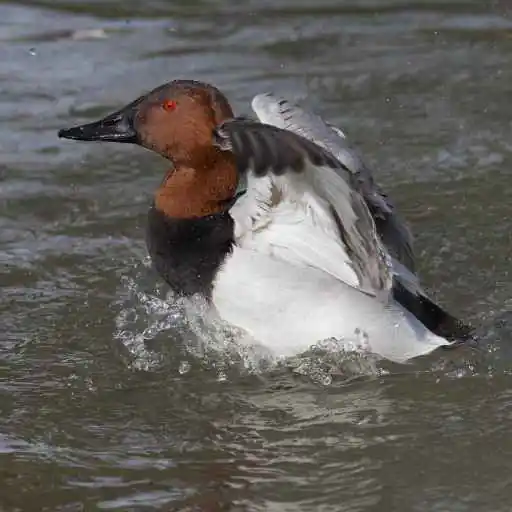
- Medium-sized duck with a distinctive sloping profile
- Inhabits freshwater habitats such as marshes, lakes, and river
- Feed mainly on aquatic plants, particularly wild celery
The canvasback (Aythya valisineria) is a unique diving duck native to North America.
It is a medium-sized bird with a distinctive sloping profile from the head to the bill, which is long and narrow with a black tip. The male has a reddish-brown head and neck with black chests, while the female has a duller brown head and grayish-brown body.
Canvasback ducks prefer to inhabit large, shallow freshwater lakes and wetlands, particularly those with submerged aquatic vegetation. They also frequent coastal bays and estuaries during the winter months.
During the breeding season, they typically nest in grassy areas near water, such as marshes or prairies adjacent to lakes or ponds. They tend to avoid heavily forested areas and fast-moving rivers or streams.
Canvasbacks feed mainly on aquatic plants, particularly wild celery (Vallisneria americana), which gives them their scientific name. These diving ducks also eat small invertebrates and mollusks. Their unique bill shape allows them to reach deep into the mud and sift out their preferred food.
Rosy-Billed Pochard
Rosy-Billed Pochard

- Endemic to South America
- Travels based on water conditions
- Seed-eaters
The rosy-billed pochard (Netta peposaca), also known as the rosybill or rosybill pochard, is a diving duck found in South America. One of the most striking features of this species is the significant sexual dimorphism exhibited by males and females.
Adult male rosy-billed pochards have a distinctive and striking appearance, with a purplish-black head, neck, and breast, gray sides, a bright red bill, and red eyes. Females are comparatively dull and brown, with a bluish-gray bill with a black tip.
Rosy-billed pochards inhabit shallow freshwater swamps, marshes, and small lakes. Their diet consists mainly of knotgrass and barnyard grasses, but they also eat seeds and other plant materials.
The rosy-billed pochard nests in areas hidden in tall grass. Their nesting habits are generally secretive and not well studied. However, it is known that they lay between 5 and 10 eggs at a time, and the incubation period lasts for around 25 days.
The population distribution of the rosy-billed pochard is limited to Argentina, Bolivia, Brazil, Chile, Paraguay, Peru, and Uruguay. These birds migrate seasonally in response to the changing water conditions, food availability, and nesting requirements.
White-Winged Duck
White-Winged Duck

- Extinct species of duck found in southern India and southeast Asia
- One of the largest ducks
- Eats both plants and small animals
The white-winged duck (Asarcornis scutulata) is a large dabbling duck, also known as the white-winged wood duck. It is one of the largest ducks, with a dark body and a distinctive white head and neck.
Females are typically smaller than males. While the males have a more vibrant plumage, both genders have the same basic coloration, with the male’s colors slightly more pronounced.
The white-winged duck is a primarily nocturnal and secretive feeder with a diet that includes plants and small animals. It prefers to inhabit swamp forests surrounded by slow-flowing wetlands, which provide both cover and suitable habitat for feeding.
The white-winged duck is an endangered species, with populations declining rapidly due to habitat loss and hunting. It is already extinct on the island of Java. The species remains at risk despite conservation efforts, with continued threats to its habitat and breeding grounds.
Key Takeaways on Ducks with Red Eyes
- Ducks with red eyes include both wild and domestic ducks.
- These ducks prefer wetland habitats with dense vegetation.
- These ducks have a varied diet consisting of plant and animal matter.

